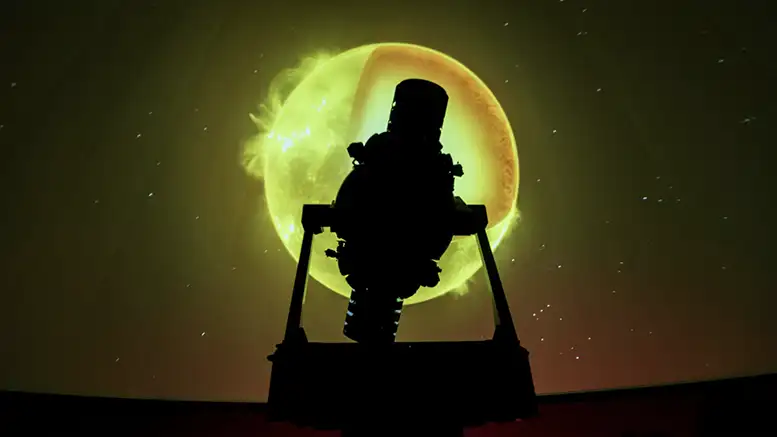By Ball State Marketing & Communications—
MUNCIE, IN – Ball State University is collaborating with NASA to provide live broadcast coverage of the total solar eclipse on April 8.
Dayna Thompson, director of the Charles W. Brown Planetarium, and Dr. John Millis, department chair of the Department of Physics and Astronomy and professor of physics, will serve as telescope operators during the eclipse at Indianapolis Motor Speedway. NASA plans to livestream the eclipse from multiple sites, including from the Ball State telescopes in Indianapolis.
“We are grateful to NASA for including our University in its coverage of this awe-inspiring total solar eclipse,” Ms. Thompson said. “Through our telescopes, viewers will witness one of nature’s greatest spectacles.”
NASA will provide live eclipse broadcast coverage from 1-4 p.m. ET April 8 on NASA+, NASA TV, NASA.gov, the NASA app, and on YouTube. Other venues being utilized by NASA to broadcast the eclipse include the Kerrville Eclipse Festival in Kerrville, Texas; the Southern Illinois Crossroads Eclipse Festival in Carbondale, Ill.; and the Great Lakes Science Center’s Total Eclipse Fest 2024 in Cleveland, among other locations.
April 8 will represent the first total solar eclipse to pass over Muncie since 957CE. The eclipse will begin on Ball State’s campus around 1:52 p.m. ET, when the Moon starts to block out the southwest side of the Sun. From around 3:07-3:11 p.m.—or a totality of about three minutes and 40 seconds—Ball State will be plunged into deep twilight as the Moon hides the Sun from the sky. The eclipse will end around 4:24 p.m.
NASA will be utilizing two Ball State-run telescopes for its broadcast feed from Indianapolis on the day of the eclipse:
- Setup 1:
- Telescope: 90mm SVBONY Refractor
- Camera: Canon EOS R10
- Filter: White Light
- Setup 2:
- Telescope: 90mm Coronado SolarMax III
- Camera: ZWO – ASI294MC Pro Color
- Filter: Hydrogen-alpha
According to Ms. Thompson, the Hydrogen-alpha filtered telescope allows viewers to see the Sun in a very specific color of red light which shows its atmospheric region—the chromosphere. This allows people to see dramatic features of the Sun that solar eclipse glasses do not show, such as solar prominences, filaments, and flares.
The white light filtered telescope, meanwhile, shows a similar view as to what solar eclipse glasses show, but safely magnified to show details such as sunspots and features in the Moon’s edge as it eclipses the Sun.
More importantly, with this telescope and camera setup, the filter can be taken off during totality, when the Sun’s bright disk is completely obscured by the Moon, showing viewers outside the path of totality a look at the outer atmosphere of the Sun, its corona, and prominences. While it’s not the same as seeing it in real life, according to Ms. Thompson, this allows viewers from all over the world to enjoy totality in real-time alongside the millions of people watching from the narrow band of totality that spans the Americas.
From Friday, April 5, through Sunday, April 7, the planetarium and other University entities, such as the David Owsley Museum of Art and the Dr. Joe and Alice Rinard Orchid Greenhouse, will also present a series of programs, workshops, and lectures about the total solar eclipse. A full list of campus eclipse-related events is available on the University’s online calendar.
For those looking to experience the total eclipse on April 8, Ball State is encouraging visitors to participate in the programming being hosted by the City of Muncie and the Muncie Visitors Bureau. More information—including resources, viewing sites, lodging, activities, and more—can be found on the Muncie Eclipse website.
Eclipse viewers will need protective solar glasses to view the Sun directly during all partial phases of the solar eclipse. Visit the Ball State Solar Eclipse webpage to learn more about solar eclipses in Muncie, how to obtain eclipse glasses, and more.
Ball State’s Charles W. Brown Planetarium is an immersive theater where state-of-the-art technology transforms the 16-meter (roughly 52-foot) dome—the largest in Indiana—into a simulation of the night sky as seen from Earth and from space. The facility, part of the College of Sciences and Humanities‘ Department of Physics and Astronomy, has more than 150 reclining seats that allow guests to comfortably view projections from the planetarium’s GOTO CHRONOS II HYBRID system, which includes an RSA Cosmos digital 4K system to display amazing visualizations based on real scientific data.
The planetarium is named in honor of businessman and philanthropist Charles W. Brown, a 1971 Ball State graduate whose acts of generosity to his alma mater include being the lead donor for both the updated planetarium project in 2014 and the new Brown Family Amphitheater, located in the heart of campus.
About Ball State
Founded in 1918 and located in Muncie, Ball State University is one of Indiana’s premier universities and an economic driver for the state. Ball State’s 20,000 students come from all over Indiana, the nation, and the world. The 790-acre campus is large enough to accommodate first-rate facilities and 19 NCAA Division I sports, but our welcoming and inclusive campus is small enough to ensure the friendliness, personal attention, and access that are the hallmarks of the University. Destination 2040: Our Flight Path establishes Ball State’s ambitious goals for our second century. We Fly!



